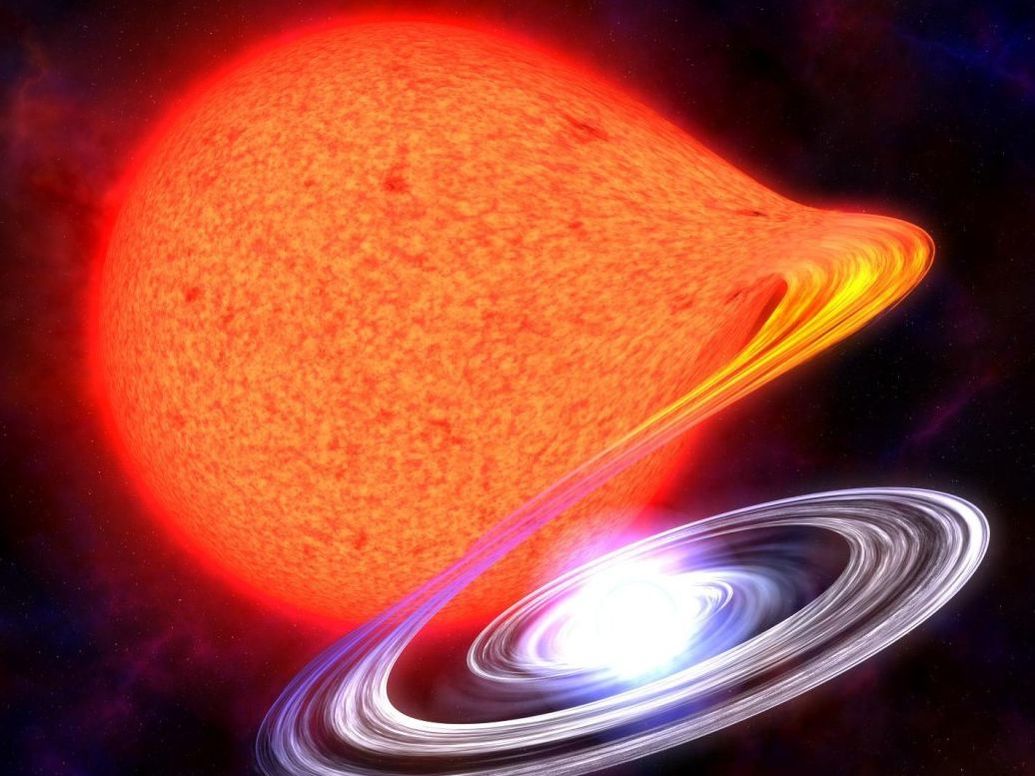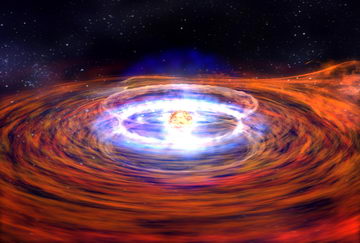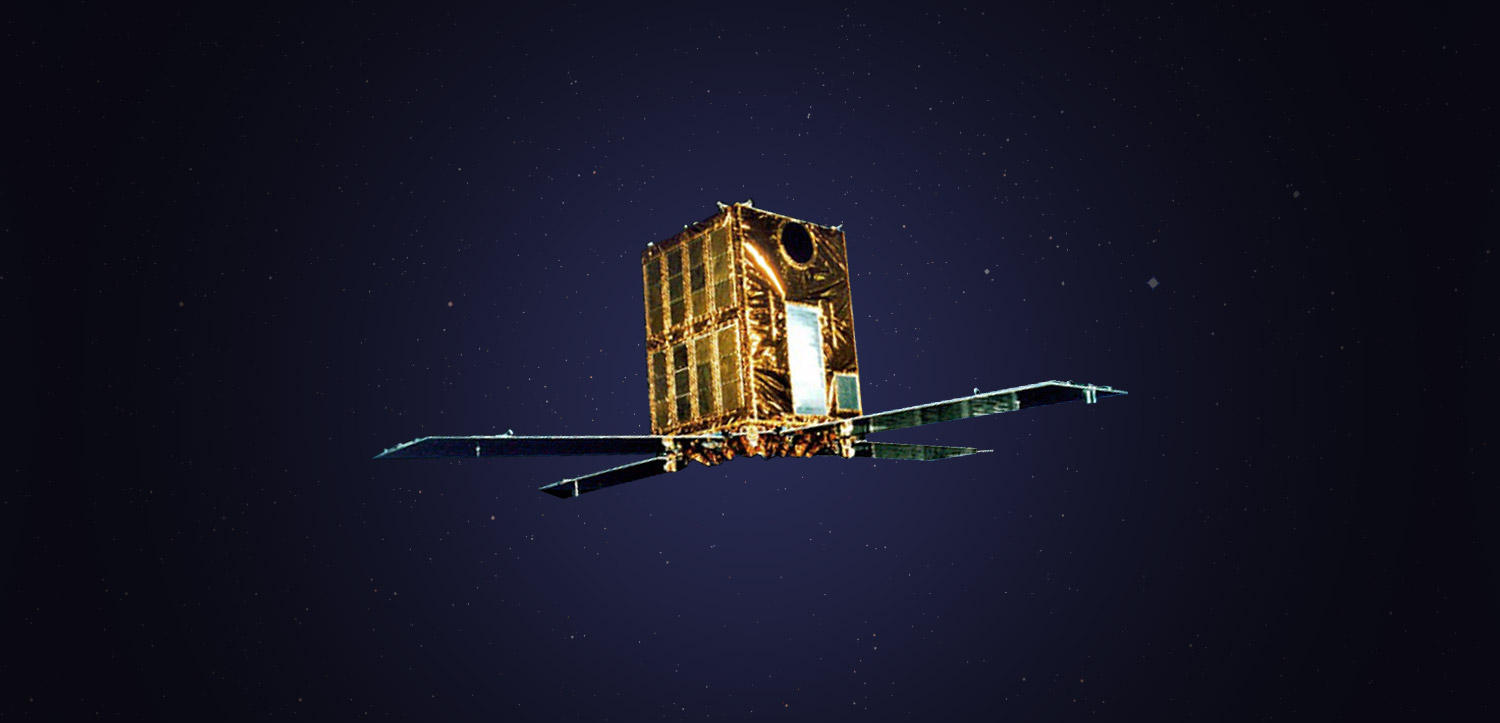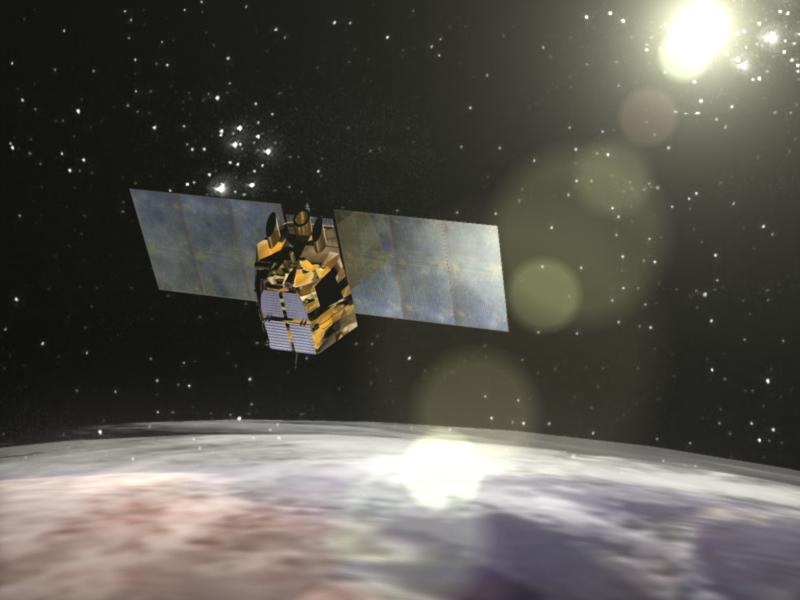Type-I X-Ray Burst
A small but highly dense neutron star cannibalizes its larger Sun-like companion star in a low mass X-ray binary star system ...

Artistic representation of a neutron star accreting matter from its companion’s envelope.
Stars of approximate 12 times or more than the mass of our Sun terminate their lives in the so-called supernovae which are extremely violent explosions that produce neutron stars. More often than not, supernovae are asymmetric, and the produced neutron stars are kicked with velocity up to 550 km/s to meet with a lifelong companion star if they are lucky or else they will be a lone ranger in a galaxy. A neutron star could be around 1.5 times or more the mass of our sun and have only a diameter of around 24 km which is less than 3 times the height of Mount Everest.

Neutron stars are extremely massive. It just like compressing 1.5 times the mass of the Sun to within 3 times the size of Mount Everest, causing its gravitational pull much stronger than the Sun. If the kicked neutron star is close enough to a lifelong companion star having around the mass of our Sun, they both orbit around one another and form a binary system. Meanwhile, the main compositions of stellar fuel of the companion star, i.e., hydrogen and helium, are siphoned to the neutron star due to the enormous gravitational force of neutron star. An envelope surrounding the neutron-star atmosphere is formed. The stellar fuel of hydrogen and helium in the envelope is further compressed and then fused to form heavier chemical elements, like carbon, oxygen, and nitrogen. Such fusions keep adding hydrogen or helium to the freshly formed heavier elements, more and more heavy elements are synthesized, until the accreted stellar fuel is exhausted. Image credit: NASA/Dana Berry
Throughout the fusion process, energetic X-rays of thousands of times brighter than our Sun are emitted from the extremely high density envelope. Such energetic X-ray pulses are termed Type-I X-ray bursts. Also, the couple of a neutron star and its companion star giving birth to these bursts are called X-ray bursters, for example, the recently most investigated GS 1826–24 X-ray clocked burster which has the characteristic of almost consistent light curve shape, and the SAX J1808.4–3658 X-ray burster. Subsequent rounds of fusion processes generating strong X-ray pulses could also occur as long as there are enough following clumps of stellar fuels. These X-ray signals can be detected by sensitive telescopes mounted on satellites, like GINGA, Rossi X-ray Timing Explorer (RXTE), Swift, BeppoSAX, and the Monitor of All-sky X-ray Image (MAXI).
Up to date, more than 7000 X-ray bursts emitted from more than 115 X-ray bursters have been observed. Nevertheless, none of these observed bursts can be closely reproduced by theoretical models. One of the underlying reason is due to the vast uncertainties in important fusion reactions influencing the onset of X-ray bursts. The other reason is because of the astrophysical models.
Type-I X-Ray Clocked Burster
The GS 1826−24 clocked burster is the most investigated X-ray burster due to its nearly consistent accretion rate and periodic burst light curve. Its X-ray bursts is a natural laboratory to probe the rapid-proton process path, neutron-star compactness, and the equation of state of the host neutron star. The best model describing the GS 1826−24 light curves is highly desired within the community. The first quantitative comparison of its modeled and observed light curves could only be achieved 19 years after its discovery by Heger (2007). However, up to now, the modeled burst tail does not exactly conform with observation. The GS 1826–24 burster was discovered by GINGA (aka ASTRO-C).
 Image credits: Institute of Space and Astronautical Science, Japan Aerospace Exploration Agency.
Image credits: Institute of Space and Astronautical Science, Japan Aerospace Exploration Agency.
With the help from nuclear astrophysics, we have advanced the GS 1826−24 clocked burst model with several newly deduced reactions, e.g., the 22Mg(α,p)25Al reaction, see Physical Review Letters 127, 172701 (2021)
Type-I X-Ray Photospheric Radius Exansion Burster
Up to now, more than 115 X-ray bursters have been discovered, and more than 62 X-ray sources are identified as photospheric radius expansion (PRE) bursters. Although more than half of the discovered X-ray sources belong to PRE bursters, the internal structure and detail hydrodynamics of PRE bursters are still not understood due to the intricate hydrodynamics. For instance, the accretion-powered millisecond pulsar SAX J1808.4–3658 powered up the brightest Type-I X-ray burst recorded by NICER in recent history. The SAX J1808.4–3658 burster was found by BeppoSAX.
 Artistic view of BeppoSAX. Image from: ScienceSprings.
Artistic view of BeppoSAX. Image from: ScienceSprings.
We collaborated with experimental nuclear astrophysicists to implement their new and more precise 22Mg(α,p)25Al reaction rate to advance the pioneering SAX J1808.4−3658 PRE burst model. See Physical Review Letters 127, 172701 (2021).
Publications
-
N. Lu, Y. H. Lam, A. Heger, Z. X. Liu, H. Yamaguchi, New 63Ga(p,γ) 64Ge and 64Ge(p,γ) 65As reaction rates corresponding to the temperature regime of thermonuclear x-ray bursts, Physical Review C 110, 065804 (2024)
-
Y. H. Lam, Z. X. Liu, A. Heger, A. M. Jacobs, N. Lu, Z. Johnston, The Impact of the New 65As(p,γ)66Se Reaction Rate on the Two-Proton Sequential Capture of 64Ge, Weak GeAs Cycles, and Type-I X-Ray Bursts such as the Clocked Burster GS 1826−24, The Astrophysical Journal 929, 72 (2022)
-
Y. H. Lam, N. Lu, A. Heger, A. M. Jacobs, N. A. Smirnova, T. K. Nieto, Z. Johnston, S. Kubono, The Regulated NiCu Cycles with the New 57Cu(p,γ)58 Zn Reaction Rate and the Influence on Type-I X-Ray Bursts: GS 1826−24 Clocked Burster, The Astrophysical Journal 929, 73 (2022)
-
Y. H. Lam, N. Lu, A. Heger, A. M. Jacobs, N. A. Smirnova, T. K. Nieto, Z. Johnston, S. Kubono, Regulated NiCu Cycles with the New 57Cu(p,γ)58Zn Reaction Rate and the Influence on Type-I X-Ray Bursts: GS 1826−24 Clocked Burster, EPJ Web Conf. 260, 11023 (2022)
-
Y. H. Lam, A. Heger, Z. Johnston, A. J. Goodwin, Sensitivity Study of Nuclear Reactions Influencing Photospheric Radius Expansion X-Ray Bursts, EPJ Web Conf. 260, 11028 (2022)
-
H. Yamaguchi, …, Y. H. Lam, et al., Experimental Studies on Astrophysical Reactions at the Low-Energy RI Beam Separator CRIB, EPJ Web Conf. 260, 03003 (2022)
-
J. Hu, H. Yamaguchi, Y. H. Lam, A. Heger, D. Kahl, et al., First Measurement of 25Al+p Resonant Scattering Relevant to the Astrophysical Reaction 22Mg(α,p)25Al, EPJ Web Conf. 260, 05001 (2022)
-
J. Hu, H. Yamaguchi, Y. H. Lam, A. Heger, D. Kahl, et al., Advancement of Photospheric Radius Expansion and Clocked Type-I X-Ray Burst Models with the New 22Mg(α,p)25Al Reaction Rate Determined at Gamow Energy, Physical Review Letters 127, 172701 (2021)
-
Y. H. Lam, J. J. He, H. Schatz, B. A. Brown, A. Parikh, New Reaction Rates of 64Ge(p, γ)65As(p, γ)66Se and the Impact on Type I X-ray Bursts, Proceeding of Science 281, 0144 (2017).
-
Y. H. Lam, J. J. He, A. Parikh, H. Schatz, B. A. Brown, New Thermonuclear Reaction Rates of 64Ge(p, γ)65As and 65As(p, γ)66Se for Type-I X-Ray Bursts, EPJ Web of Conferences 109, 05005 (2016).
-
Y. H. Lam, J. J. He, A. Parikh, H. Schatz, B. A. Brown, M. Wang, B. Guo, Y. H. Zhang, X. H. Zhou, H. S. Xu, Reaction Rates of 64Ge(p, γ)65As and 65As(p, γ)66Se and the Extent of Nucleosynthesis in Type I X-Ray Bursts, The Astrophysical Journal, 818, 78 (2016).